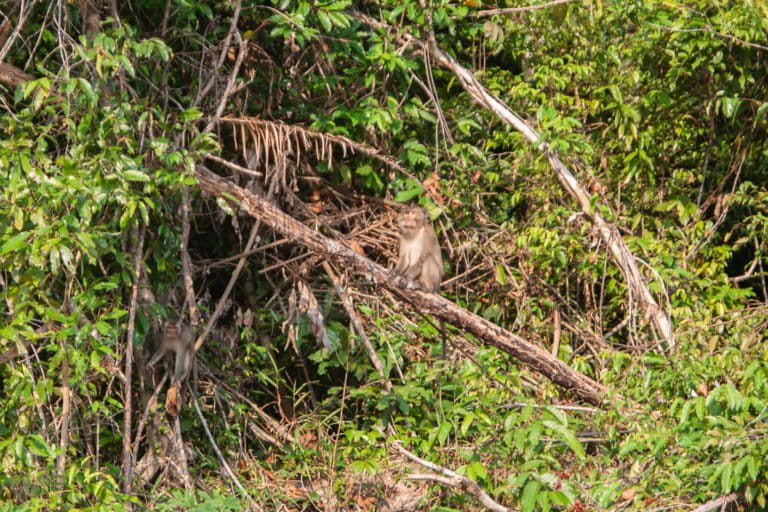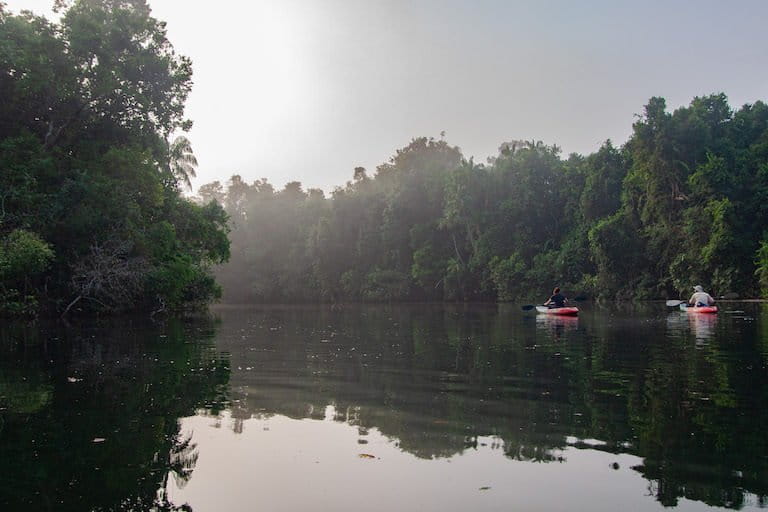
- Cambodia’s 2021 signing into law of Sub-decree No. 30, which removed official protection from some 127,000 hectares of land formerly included in national parks, reserves and wildlife sanctuaries in Koh Kong province, has conservationists concerned about the ecological integrity of southern Cambodia.
- But experts caution that other protected areas in the country are hardly faring better, claiming that “a lack of commitment and vision, systemic corruption at varies levels and competing interests by state and private actors” is contributing to the rapid degradation of Cambodia’s remaining protected forest.
- There is some agreement between conservationists and government officials that the country does not have the resources to effectively manage its protected areas.
- As a solution, some point to Africa, where public-private ecotourism partnerships have been successful at preserving habitat. But others disagree.
This is the third article in a three-part series. Read Part One and Part Two.
PHNOM PENH, Cambodia — In March 2021, Cambodia signed into law Sub-decree No. 30, which removed official protection from some 127,000 hectares of land formerly included in national parks, reserves and wildlife sanctuaries in Koh Kong province. Purportedly done to grant land rights to local communities, a 2021 Mongabay investigation revealed that land brokers with links to government officials were buying up large expanses of this now-obtainable land.
The move cast a pall of uncertainty over the future of Koh Kong’s wildlife, as well as multinational conservation projects planned for the region. Fauna and Flora International, who have launched numerous projects in the area, declined to comment on the potential impacts that the sub-decree could have on their work.
Meanwhile, the World Bank, which kicked off a $50.66 million project aimed at enhancing ecotourism and the management of protected areas in the Cardamoms region also declined to answer questions on whether they were aware of the planned sub-decree when their project launched in 2019 or how it would alter their multi-million dollar conservation investment.

All of this, in turn, raises greater questions over the purpose and future of Cambodia’s protected areas.
Neth Pheaktra, spokesperson for the Ministry of Environment, said that a 2018 assessment of Cambodia’s protected areas found that some 7.3 million hectares of forest land were under the Ministry of Environment’s jurisdiction, equivalent to 41% of Cambodia’s total landmass, which are patrolled by just 1,200 rangers from the ministry.
“So, a ranger is caring [for] around 6,000 hectares of protected areas,” Pheaktra said. “[The Ministry of Environment’s] forest rangers are working with high responsibility and professionalism to manage and conserve the protected areas in collaboration with NGO partners and Protected Areas Communities and relevant authorities.”
Pheaktra described his pride at the scale of protected areas listed in Cambodia, adding that under the Ministry of Environment, Cambodia had more than met its 2020 Aichi Biodiversity Targets, which demanded that at least 17 percent of terrestrial and inland water be protected, alongside 10 percent of marine and coastal area.
“Cambodia has achieved three times more than [the] Aichi Target on terrestrial areas,” he said, going on to note that increasing REDD+ programs across the country and expanding ecotourism opportunities should see Cambodia halve its rate of deforestation by 2030.

With the Environment Ministry’s budget of $9.25 million in 2021 dropping slightly to $9.07 million for 2022, Pheaktra said that “Under complete peace, Cambodia has a full opportunity to consider the conservation of its natural resources.”
He also claimed that large-scale illegal logging operations have been stamped out. However, activists and scientists have used satellite imagery to show that such operations appear to be continuing, despite the efforts of the Environment Ministry.
But while Pheaktra would not say whether the sub-decree is a means of redefining those protected areas or an attempt at reducing them to more manageable conservation zones, experts remain unconvinced by the idea that certain areas listed in the sub-decree were the right place to start such an endeavor.
“Cambodia has one of the highest levels of protected land in Asia, but the level of resources available to protect that land is much lower than required,” said Thomas Gray, a conservation biologist with extensive experience in Cambodia. “The law is strong enough to protect protected areas, but the issue is the lack of resources to implement that law.”
Gray questioned the viability of Cambodia’s current stock of protected areas, arguing that the 2008 Law on Protected Areas was drafted largely by experts from the United Nations and NGOs who may have had a different vision for protected areas than the one currently envisioned by the Ministry of Environment.
With resources for the Ministry of Environment limited, even if rangers were committed to conservation—and not embroiled in corruption and illegal logging operations as is alleged in Prey Lang Wildlife Sanctuary—Gray said that there is limited financial incentive to protect Cambodia’s forests and limited opportunities for provincial administrations to foster economic development in areas like Koh Kong where the majority of land is protected.

To more effectively manage protected areas and to bolster the Ministry of Environment’s capacity, Gray suggested Cambodia embrace the public-private partnership model that has been pioneered in numerous African countries.
“[Governments] have recognized that they do not have the resources or the capacity in the current economic situation, so they hand them over completely to other parties,” explained Gray, who said that the private-public partnership or delegated management conservation model could be beneficial to Cambodia.
Gray noted that there would of course be the potential for abuse in such a system, the likes of which saw WWF dragged before a U.S. congressional hearing in October 2021 to explain how the conservation behemoth had partnered with, funded and equipped park rangers in Asia and Africa that stand accused of torture, rape and murder in national parks WWF managed or co-managed. (WWF maintained that the rangers in question were government employees.)
“The problem is there’s a lack of government money for the management of protected areas and in some cases, a lack of confidence in donors to give that money to governments to manage the protected areas—that’s a global problem—and so delegated management is one possible way to address this,” said Gray, who added that public-private partnerships could bring about more accountability to Cambodia’s conservation efforts.
Gray called for the Ministry of Environment and all stakeholders to “take a step back, assess the biological significance and ecosystem service significance of the entire protected area network” before making further cuts to Cambodia’s protected areas. He noted that the Cardamoms is one area that still retains much of its ecological value.
“It’s not an empty forest like those in Laos or Vietnam or other forests in Cambodia that have been defaunated due to lots of hunting,” Gray said, adding that “a combination of historic remoteness, the topography and the excellent work of Wildlife Alliance, means there are more animals in the Cardamoms probably than any other forested area in Cambodia.”

Echoing this sentiment, veteran forest activist Marcus Hardtke said that due to illegal logging, encroachment and concessions, Cambodia only has such a large area of protected land on paper, presenting a misleading view of conservation.
“I wouldn’t even call these areas paper parks, rather ghost parks,” Hardtke said. “Overall, the on-paper rather large size of some protected areas is not the main issue—the key is a lack of commitment and vision, systemic corruption at various levels and competing interests by state and private actors involved.”
The Cardamoms landscape, Hardtke said, was protected because of its pristine conditions, remoteness, low population density and as a means to end the activities of predatory foreign timber companies. But he added that mountainous areas are easier to protect than lowlands, which often face pressure to be converted to farmlands or other sorts of development, and that Cambodia’s political environment allows powerful players to push their plans through, regardless of laws or well-intentioned management plans.
“In that sense, this sub-decree is a real cause of concern,” he said.
The solutions to saving Koh Kong’s wildlife and their habitats also face stark limitations, as far as Hardtke can tell.
“Ecotourism is a very useful addition to park management, but Indochina is not Africa with its charismatic megafauna and the profits it generates,” he said. “The concept of privately managed protected areas would probably fail in Cambodia based on the local natural and political conditions. Conservation remains a task for a responsible government.”
Banner image: A Ministry of Environment ranger on patrol in the Cardamom Mountains. Image by Andyb3947 via Wikimedia Commons (CC BY-SA 4.0).
Feedback: Use this form to send a message to the editor of this post. If you want to post a public comment, you can do that at the bottom of the page.
Can ecotourism save Cambodia’s ‘ghost parks’?
Source: Trends News

0 Comments